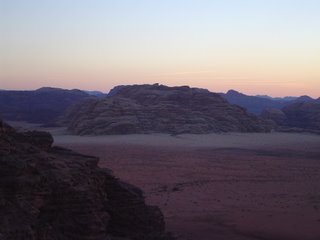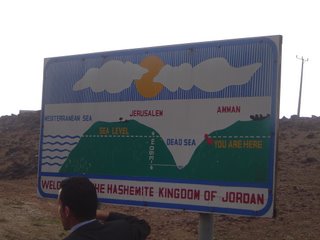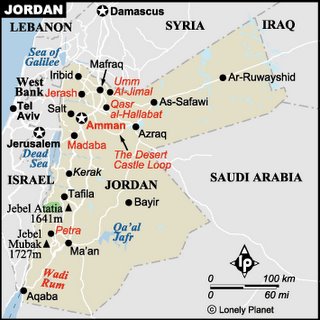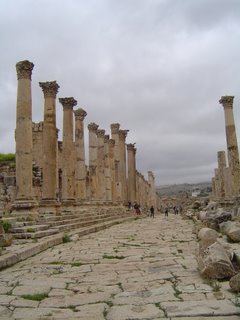Day Three Jordan










All pictures are taken at Wadi Rum, Jordan. Note in one photograph the size perspective of landforms with the jeep
You can also see in one photo how sand colour varies according to rock colouring in that area
After seeing Petra, I drove the hour and three quarters to Wadi Rum that afternoon.
Wadi Rum is desert area in the south of Jordan. I had read that Wadi Rum was a great looking place and that it had impressed Lawrence of Arabia very much. Guidebooks and websites had amped me up to have a look at the desert. The option was there to stay overnight under the stars, so why not? I arranged a night in the desert before I left England.
I was late for the meeting with the guide, Eid. I was tearing down the highway and was rightfully pulled over by the police. “Where are you from?” as everyone asked with genuine interest. “It is a 90 kmh zone and you were doing 110”
I didn’t know what to say and just did the old turning up palms with slight shrug of shoulders in a “It’s a fair cop; what am I to do? type look. (Miss Kate T acted out a great example of this in one of the Albert Street videos)
He looked at me, laughed in friendly manner and said very genuinely, “You be careful”.
I got there in time for sunset. It is without doubt a very attractive part of the world and was a unique experience for me, though throughout the night, the “I wish someone special was here to appreciate it with me” feelings would often rear their head. It would have been a very cool experience with a girlfriend. Still, it was a fantastic experience, regardless.
As mentioned in a previous post, Eid was no stranger to the world of technology with his mobile phone making mine look like it may have been used by the Nabateans back in Petra a couple of millennium ago.
In hindsight, I may have over romanticised in my head the idea of the Bedouin people living a traditional lifestyle.
Eid, the bloke looking after me, was telling me how the village weddings are expensive (there was one the week before). Pretty much everyone in the village goes.
“The feast for so many people and the goat.”, I heard him say.
“Yes,” I said confidently, feeling very culturally aware, as in my memory I recalled the act of giving a dowry in some parts of the world requires presenting livestock as a gift between families... “I guess weddings are expensive no matter where they are.”
After a few moments’ pause I tried to extend the conversation.
“Is it always Bedouin tradition to give a goat at the wedding?”
Slight pause…”Goat?..goat? no.. no… Gold....gold…. it is typical gift at wedding. Much gold. Gold is expensive. We eat the sheep and goat.”
Good food and much tea was provided and I slept on a simple thin foam mattress under the stars. The sleep was interrupted by the visit of a hedgehog looking for food.
Next day I had a two and half hour jeep tour of the desert. Besides the obvious highlight of seeing a vast desert ("...echoing, spacious and godlike..."- Lawrence of Arabia), with huge landforms and mountains, a moment that sticks well in my memory is that of seeing a mother camel with her one week old calf. We were maybe fifty metres away and I went to get a photo out of the car (near the car), though Eid suggested that I stay in the car, warning that it could turn nasty if the mother sees me as a threat.
To answer Frazer’s question, I have never been interested in discovering the Australian desert. Going to Wadi Rum was not a reason for going to Jordan, although after reading about it, it seemed silly to miss seeing it. That seems to be a recurring situation for me when travelling. I read about the area and discover many, many places that I really want to see and I feel it’s very important to see them or experience it. This results in me leading a very hectic holiday. I realise that is not everyone’s cup of tea, though it’s how it is for me.
Eid pointed out that “Saudi” was a couple of hours away across the desert.
The hire car, back in the village, had a tank almost empty, so when we got back to Rum village, Eid took me to the “petrol station” - two guys sitting in chairs outside a dark room- where he organised a jerry can to half fill up the car with cheap Benzine (from Saudi).
I headed north to The Dead Sea and Mount Nebo. I went first via the Desert Highway which is a fast route and then across to the King’s Highway to drive through Wadi Mujib, the “Grand Canyon” of the Middle East.
The Desert Highway was bizarre. Two days before I was caught up in torrential floods of rain and today the car was engulfed in sandstorms that would blow forcefully across the road. They start off as brief blasts then turned into long clouds of sand where it was necessary to slow down as visibility was very poor at times. This lasted for about forty five minutes, then there were a few series of signs for turn offs for Iraq and Saudi, neighbouring countries. Seeing those signs and knowing a short distance up the road was very much a war zone, was bizarre. Of course, I was in no danger and not once on the whole trip did I feel in any danger; though to see a reminder of my geographical position was a spin out. The terrain was very much flat, barren desert with occasional breeze block shanty town villages. Very much like the television reports from roadside Iraq. This “awareness” of where I was turned out to be one of my strongest feelings on the whole trip.
Unfortunately, for much of this day I had no camera as my batteries had run out for the digital and Lufthansa were still “looking after” my luggage.
I turned onto the King’s Highway, although it was quite foggy at times (which reminds me that on the first day driving from Jerash I drove through pea soup fog, hazard lights, 20 kmh….more extreme weather patterns in Jordan).
Despite the fog I got some fantastic glimpses of Wadi Mujib, a national park. The road follows a ridge and takes you into a deep valley and out again. Very spectacular views.
I was to catch a plane at 4 pm, so there was pressure to see a few places in a short space of time. I wanted to swim in The Dead Sea, see Madaba and Mt Nebo.
I was behind time; I tore down a huge mountain on a country road to get down to the Dead Sea. The car was sliding here and there, though I felt safe enough.
Once again, I was stopped, this time by a military man with a military tank at roadside on this tiny country road. (These stops become reasonably regular as you approach the Israeli border.
“Why do you drive quick, quick, quick?”
I explained I wanted to swim in The Dead Sea, though had to catch a plane soon. He nodded and smiled as he explained to his fellow gun toting colleague. (I know nothing of names of weaponry, though I can assure you they were, without a doubt, very serious guns indeed).
He lifted the barricade and off I continued.
In this frantic rushing and late state of mind, I had earlier pulled into a petrol station to fill up the empty tank. The fellow serving me asked, “Where are you from?”. This is typical as I said before and people do genuinely want to know about you. It was a nice thing. The petrol station man and his three mates insisted I take tea with them. This involves accepting three (small) glasses, to be polite. After one glass, I explained as best I could that I had to run off. This perhaps was tantamount to an international incident, though my tip may have helped the situation.
The tea in Jordan and Syria is very sweet, and although not a tea drinker usually, I quickly got used to it and ended up looking forward to a few cups.
The Movenpick Resort (expensive and big) is the first that you come across on the Dead Sea Highway. To enter the beach from Movenpick, it costs approximately 20 British pounds (a lot). The cheaper swimming public beach alternative was a further fifteen minutes down the road.
My luggage did not originally arrive with me and I was still without my bag (and swimmers). I had asked at the Petra Movenpick if it was possible to hire swimmers at the Dead Sea branch. “Of course, sir”
Time was of the essence. I checked in the car to the car park, which involved a form to be filled out and passport scrutinised.
Now picture a resort of extremely high standard and me walking into the reception with my boots absolutely coated in desert dust and clothes I had been wearing for three days with no shower in desert, either.
At reception I asked where I could hire the swimmers.
“You can buy them in the shop, sir”
“Buy them??... Where’s the shop?”
Down the stairs, turn to the right, follow the path and you will see it on the left next to the…..”
I ran off in the direction he pointed. Got outside and saw how incredibly huge this place was, looked at the time, added on buying swimmers time, trying them on, changing, getting to the water, shower etc and just as strong in my thoughts, I was incensed I would have to pay twenty pounds, plus whatever Movenpick charge for swimmers, for a five minute swim.
It was just all a bit ridiculous. Resigned to the fact that I was not destined to experience swimming in the Dead Sea this trip, I walked out to the car park and left for Mt Nebo.
Mount Nebo is where Moses was shown the “promised land” by God after wandering for forty years. Moses died there, as well.
As the folks at VisitJordan.com say, “When you stand at the top of this mountain, you can see, as Moses did, the vast panorama that encompasses the Jordan River Valley, the Dead Sea, Jericho and Jerusalem”
There are shepherds dotted around these mountains and they look exactly as they must have all those years ago.
Madaba was just up the road and on the way to the airport; the main interest there is mosaic map. It is the earliest known map of the Middle East (6th Century) and its importance in history is well documented. The significance was mainly lost on me at the time as I had to get to the airport.
At the airport I made a fool out of myself. I had no watch and my phone had run out of batteries (thank you once again, Herr Lufthansa). I was late, handed the car in and ran to baggage people. They gave me a piece of paper and said I needed it signed by the man in the building over there. To cut a long story short, wrong building, running back and forward, security check, sweaty, big day and all and I’m thinking I have five minutes to get plane. Eventually race and upset people on the way to discover I have extra forty five minutes up sleeve. I was so rude to anyone who held me up time-wise. It left me feeling a bit disappointed with myself.
Next was a one hour plane ride to Beirut.

















